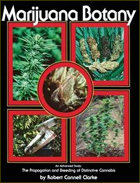
by Robert Connell Clarke
Soil Layering
Soil layering may be performed in several ways. The most common is known as tip layering. A long, supple vegetative lower limb is selected for layering, carefully bent so it touches the ground, and stripped of leaves and small shoots where the rooting is to take place. A narrow trench, 6 inches to a foot long and 2 to 4 inches deep, is dug parallel to the limb, which is placed along the bottom of the trench, secured with wire or wooden stakes, and buried with a small mound of soil. The buried section of stem may be girdled by cutting, crushed with a loop of wire, or twisted to disrupt the phloem tissue and cause the accumulation of substances which promote rooting. It may also be treated with growth regulators at this time.
Serpentine layering may be used to create multiple layers along one long limb. Several stripped sections of the limb are buried in separate trenches, making sure that at least one node remains above ground between each set of roots to allow shoots to develop. The soil surrounding the stem is kept moist at all times and may require wetting several times a day. A small stone or stick is inserted under each exposed section of stem to prevent the lateral shoot buds rotting from constant contact with the moist soil surface. Tip layers and serpentine layers may be started in small containers placed near the parental plant. Rooting usually begins within two weeks, and layers may be removed with a sharp razor or clippers after four to six weeks. If the roots have become well established, transplanting may be difficult without damaging the tender root system. Shoots on layers continue to grow under the same conditions as the parent, and less time is needed for the clone to acclimatize or harden-off and begin to grow on its own than with cuttings.
In air layering, roots form on the aerial portions of stems that have been girdled, treated with growth regulators, and wrapped with moist rooting media. Air layering is an ancient form of propagation, possibly invented by the Chinese. The ancient technique of goo tee uses a ball of clay or soil plastered around a girdled stem and held with a wrap of fibers. Above this is suspended a small container of water (such as a bamboo section) with a wick to the wrapped gootee; this way the gootee remains moist. The single most difficult problem with air layers is the tendency for them to dry out quickly. Relatively small amounts of rooting media are used, and the position on aerial parts of the plant exposes them to drying winds and sun. Many wraps have been tried, but the best seems to be clear polyethylene plastic sheeting which allows oxygen to enter and retains moisture well. Air layers are easiest to make in greenhouses where humidity is high, but they may also be used outside as long as they are kept moist and don’t freeze. Air layers are most useful to the amateur propagator and breeder because they take up little space and allow the efficient cloning of many individuals.

